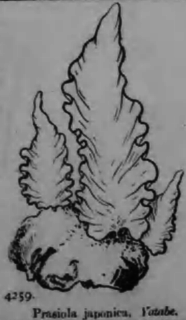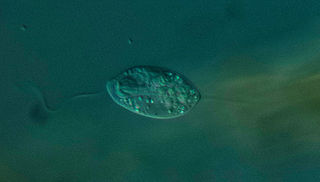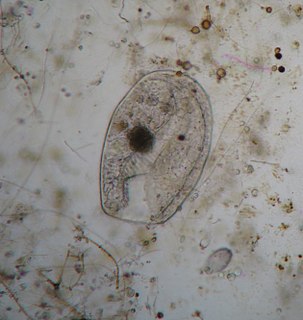
Prasiola is a genus of fresh water and marine green algae. Each individual plant is small but they usually grow side by side to form a green turf on rock surfaces. The genus has a cosmopolitan distribution.

Oscillatoria is a genus of filamentous cyanobacterium which is often found in freshwater environments, such as hot springs, and appears blue-green. Its name refers to the oscillating motion of its filaments as they slide against each other to position the colony facing a light source. Oscillatoria reproduces by fragmentation, facilitated by dead cells which separate a filament into separate sections, or hormogonia, which then grow. Oscillatoria uses photosynthesis to survive and reproduce. Each filament of oscillatoria consists of trichome which is made up of rows of cells. The tip of the trichome oscillates like a pendulum. In reproduction, it takes place by vegetative means only. Usually the filament breaks into a number of fragments called hormogonia. Each hormogonium consist of one or more cells and grow into a filament by cell division in one direction.

Anisonema is a genus of colorless flagellates that occur in marine, brackish, and freshwater habitats. The cell is typically ovoid, somewhat flattened, and rigid. The name Anisonema derives from Greek for "unequal thread", in reference to the two flagella that are of unequal lengths. The shorter flagellum extends forwards and propels movement with a sweeping motion, while the longer flagellum, up to three times the length of the cell, trails behind, with jerking contractions.
Goniomonas is a genus of Cryptomonads and contains five species. It is a genus of single-celled eukaryotes, including both freshwater and marine species. It lacks plastids, which is very unusual among all of the Cryptophyte genera. It may reflect one of only a small number of times that the Cryptophytes evolved into freshwater habitats. Goniomonas seems to have a number of freshwater relatives which have not yet been cultured and named.
Giovanni Battista de Toni was an Italian botanist, mycologist and phycologist.
Spirulina abbreviata is a marine cyanobacteria from the genus Spirulina.
Spirulina agilis is a freshwater cyanobacteria from the genus Spirulina.
Spirulina agilissima is a freshwater cyanobacteria from the genus Spirulina.
Spirulina albida is a chlorophyll-free, heterotrophic and saprotrophic freshwater cyanobacterium from the genus Spirulina. "Spirulina albida" occur in surface films.
Spirulina ardissoni is a cyanobacteria from the genus Spirulina.

Batrachospermaceae is a family of fresh water red algae (Rhodophyta). Genera within the Batrachospermaceae generally have a "Lemanea-type" life history with carpospores germinating to produce chantransia. Sporophyte phase with meiosis occurs in an apical cell to produce the gametophyte stage. Pit connections have two pit plug cap layers with the other layer enlarged. This family of freshwater red algae is uniaxial, meaning each filament with a single apical cell. The genera included within Batrachospermaceae are listed in the table below.

Bursaria is a genus of ciliates in the class Colpodea. They are relatively large and feed on other protists in freshwater habitats.
Navicula depressa is a freshwater species of algae of in the genus Navicula. Navicula depressa occurs in Fennoscandia.
Navicula bita is a freshwater species of algae in the genus Navicula.
Navicula cari is a species of algae in the genus Navicula. Navicula cari occur in eutrophic waters.
Navicula elegans is a marine and freshwater species of algae of the genus of Navicula.
Geminella minor is a species of filamentous freshwater green alga in the family Chlorellaceae. The species probably has a cosmopolitan distribution. The type specimen came from Switzerland and the species has been reported in the British Isles and elsewhere in the northern hemisphere, including Japan, Ukraine and North America. It occurs in freshwater aquatic habitats.

Prasiola calophylla is a species of algae.





